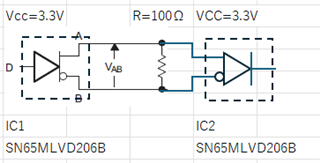Tool/software:
Hi,
I have some question about using SN65MLVD206B.As shown in the figure below, the SN65MLVD206B is used for both the driver and receiver.
The M-LVDS is 100 ohm terminated. The M-LVDS line has an amplitude of 1.0 V on the P-side and 1.0 V on the N-side.
The amplitude seems to be large. Is there a problem?
Is there any problem with 100 ohm termination for M-LVDS line?
Best regards,
Hyodo



